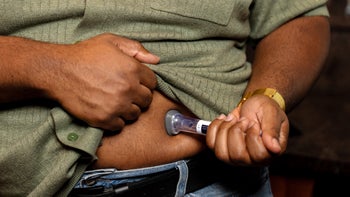
How Long Does It Take for Mounjaro to Work? Plus 5 More Mounjaro FAQs
Key takeaways:
Mounjaro (tirzepatide) is an injectable medication that’s FDA approved to treat Type 2 diabetes in adults. But it’s also commonly used off-label for weight loss.
Mounjaro starts working within hours of injection. But you may not notice a significant change in your blood glucose (sugar) levels or body weight during the first 4 weeks. And it can take anywhere from 4 to 6 months to see its full effects.
Each dose of Mounjaro remains in your system for several days, which is why you only need to inject doses once a week. Mounjaro is intended for long-term use. Your diabetes care team will help you determine how long you should continue using the medication.
Mounjaro is safe for most adults with Type 2 diabetes. Common side effects include nausea, diarrhea, and vomiting. It’s not recommended for people with a history of medullary thyroid cancer or multiple endocrine neoplasia type 2 (MEN2) syndrome.
Table of contents

Mounjaro (tirzepatide) is a once-weekly injection that can help lower blood glucose (sugar) in adults with Type 2 diabetes. It works best when combined with a diabetes-friendly diet and regular exercise. The active ingredient in Mounjaro — tirzepatide — is also approved for weight loss under a different brand name: Zepbound.
Mounjaro is the only diabetes medication in its class. And it may work better than similar Type 2 diabetes medications.
But how long does it take for Mounjaro to work? And is it safe to use? Here are answers to these and other common questions about Mounjaro.
Search and compare options
1. How long does it take for Mounjaro to work?
Mounjaro starts to work in your body within hours of the first injection. Some people have reported noticing its initial effects, such as feeling fuller after eating, within as little as 12 hours.
This timeframe can vary, though. Clinical trials show that people typically start experiencing Mounjaro’s glucose-lowering effects about 4 weeks after starting treatment. And it’s possible that you’ll notice some weight loss during this same period.
These benefits should continue as your body adjusts to the medication. Mounjaro’s full glucose-lowering effects peak around 4 to 6 months after starting it.
Weight loss typically continues longer than this. Studies that looked at tirzepatide’s weight loss effects ran for over 1 year. People lost the greatest amount of weight during the first 8 months after starting tirzepatide. And those that continued using it were able to maintain this weight loss long term.
2. How does Mounjaro work?
Mounjaro is a dual glucose-dependent insulinotropic polypeptide (GIP) and glucagon-like peptide-1 (GLP-1) receptor agonist. It acts like GIP and GLP-1, two gut hormones in the body. These hormones help balance glucose levels and regulate appetite.
Mounjaro lowers your blood glucose by:
Encouraging your pancreas to release more insulin after you eat
Decreasing the amount of new glucose your liver makes
Moving glucose from your blood into your cells more efficiently
Making your body more sensitive to its natural insulin
Mounjaro also has effects that help promote weight loss. These include:
Slowing the passage of food from the stomach to the intestines
Targeting areas of the brain that regulate appetite and food cravings
Balancing levels of hunger hormones in the body
These actions are why Mounjaro is sometimes prescribed off-label for weight loss.
How to take Mounjaro: Do you need to inject Mounjaro with food? Is there a best time of day to take it? Pharmacists share their tips for using and storing this diabetes medication.
What does it feel like to take Mounjaro? Three people share their experiences with this medication, which can be beneficial for people living with Type 2 diabetes.
Can a nutritious diet boost Mounjaro’s effects? One woman discusses how her diet has changed and become more health-focused since she started Mounjaro.
How much does Mounjaro lower A1C?
Clinical trials show that Mounjaro can lower your A1C by as much as 2% at the highest dosage (15 mg per week). Your hemoglobin A1C (HbA1c or A1C) represents your average blood glucose over the past 3 months.
About 90% of people using Mounjaro were able to get their A1C lower than 7% (a common goal for people with diabetes). What’s more, about half of Mounjaro users lowered their A1C to less than 5.7%. People without diabetes typically have A1C levels of 5.7% or less.
3. How much body weight may you lose with Mounjaro?
In clinical trials, people lost as much as 28 lbs after using the highest dose of Mounjaro (15 mg) for about 10 to 12 months. In these same trials, close to 90% of participants using this dose lost at least 5% of their starting body weight. And 45% of people lost at least 15%.
Everyone’s experience with Mounjaro and weight loss is unique. In general, higher doses typically lead to greater weight loss. But these doses are also more likely to cause digestive side effects, such as nausea and diarrhea.
4. How long does Mounjaro stay in your system?
Mounjaro is a long-acting medication. Small amounts of the medication may be in your system for up to 25 days. But its effects start to wear off after about a week you inject it. So if you are preparing for an upcoming surgery, you may need to stop Mounjaro 1 week before the procedure.
5. How long do you have to take Mounjaro?
Like other diabetes medications, Mounjaro is intended for long-term use. So it’s likely you’ll use this medication for several years. And it’s possible that you may need to take it for life.
Type 2 diabetes is a chronic health condition, and there is currently no cure. But using Mounjaro can help manage your blood glucose and reduce the risk of diabetes complications.
It’s common to notice improvements in glucose after a few weeks of starting Mounjaro. If you stop using it, your glucose and A1C levels may return to what they were before you started. If you want or need to stop Mounjaro, speak with your diabetes care team. They can help determine next steps for you to follow.
Will you regain body weight after you stop using Mounjaro?
Yes. If you lost weight while using Mounjaro, it’s likely that you’ll regain some weight if you stop the medication. Studies found that people who stopped using tirzepatide regained an average of 14% of their body weight back during the following year.
6. Is Mounjaro safe to use?
Yes. Mounjaro is considered safe for most people to use for the treatment of Type 2 diabetes. However, be sure to share your full medical history with your diabetes care team prior to starting Mounjaro.
Nausea, diarrhea, and vomiting are common side effects people have when using Mounjaro. Some have also reported constipation, bloating, and burping. Most of these side effects are mild and improve as your body gets used to the medication.
Rarely, people using Mounjaro report these more serious side effects:
Low blood glucose (hypoglycemia), especially when combined with insulin or other medications that promote insulin release, such as glyburide or glimepiride
Allergic reactions, including serious reactions such as anaphylaxis
Kidney damage, particularly if you’re experiencing a lot of vomiting or diarrhea
Temporary worsening of diabetic retinopathy (an eye condition caused by diabetes)
Gallbladder disease, including gallstones and inflammation of the the gallbladder
A higher risk of thyroid C-cell tumors was also seen in animal studies of Mounjaro. This hasn’t been seen in human studies. But to be safe, the manufacturer recommends that people with the following conditions shouldn’t use Mounjaro:
A personal or family history of medullary thyroid cancer
Multiple endocrine neoplasia type 2 (MEN2) syndrome
Does Mounjaro cause pancreatitis?
No, Mounjaro doesn’t seem to directly cause pancreatitis (swelling of your pancreas). It can, however, cause or contribute to gallbladder disease, which can raise your risk of pancreatitis.
A small number of people using Mounjaro in clinical trials developed pancreatitis. But a similar percentage of people using other diabetes medications or a placebo (an injection with no medication in it) also developed it. Using this evidence, researchers have determined that Mounjaro doesn’t directly cause pancreatitis.
How to save on Mounjaro
There are ways to save on Mounjaro, which is available as a brand-name medication. If you have commercial insurance, you may be eligible to pay as little as $25 per prescription through the manufacturer’s copay savings program.
The bottom line
Mounjaro (tirzepatide) starts working within hours of your first injection. It’s common to notice its initial effects on your blood glucose (sugar) and body weight about 4 weeks after starting treatment. You should see the full glucose-lowering effects of Mounjaro about 4 to 6 months after starting it. It’s intended for long-term use.
Mounjaro stays in your system for a while after you inject it. It takes about 25 days for your body to fully clear the medication.
Mounjaro is considered safe for most adults for the treatment of Type 2 diabetes. Be sure to talk with your diabetes care team about your medical history before starting Mounjaro. They can help determine if it’s the right medication for you.
Why trust our experts?



References
Aronne, L. J., et al. (2023). Continued treatment with tirzepatide for maintenance of weight reduction in adults with obesity: The SURMOUNT-4 randomized clinical trial. JAMA.
Eli Lilly and Company. (2024). Mounjaro - tirzepatide injection, solution [package insert].
Farzam, K., et al. (2024). Tirzepatide. StatPearls.
Fezza, R. et al. (2023). Emerging anesthesia risks with semaglutide. Plastic & Reconstructive Surgery.
Heise, T., et al. (2023). Tirzepatide reduces appetite, energy intake, and fat mass in people with type 2 diabetes. Diabetes Care.
National Cancer Institute. (n.d.). MEN2 syndrome. National Institute of Health.
National Cancer Institute. (2019). Medullary thyroid cancer (MTC). National Institute of Health.
PubChem. (2025). Tirzepatide. National Library of Medicine.
Rosenstock, J., et al. (2021). Efficacy and safety of a novel dual GIP and GLP-1 receptor agonist tirzepatide in patients with type 2 diabetes (SURPASS-1): A double-blind, randomised, phase 3 trial. The Lancet.
Sinha, R., et al. (2023). Efficacy and safety of tirzepatide in type 2 diabetes and obesity management. Journal of Obesity and Metabolic Syndrome.
Zeng, D., et al. (2023). Safety issues of tirzepatide (pancreatitis and gallbladder or biliary disease) in type 2 diabetes and obesity: A systematic review and meta-analysis. Frontiers in Endocrinology
Was this page helpful?
Related Articles
Browse medications
View AllResearch prescriptions and over-the-counter medications from A to Z, compare drug prices, and start saving.




























